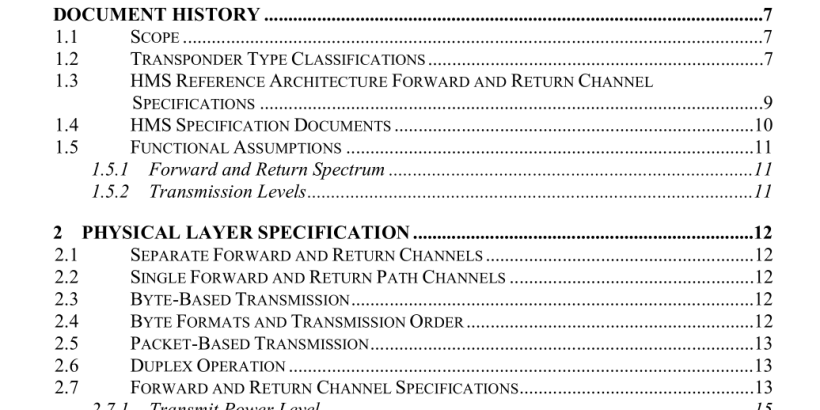ANSI SCTE 25-1-2017 pdf download.Hybrid Fiber Coax Outside Plant Status Monitoring – Physical (PHY) Layer Specification v1.
1.5.1 Forward and Return Spectrum
The forward spectrum in HFC cable systems refers to the passband of frequencies with a lower edge of between 48 MHz and 87.5 MHz, depending on the particular geographical area, and an upper edge that is typically in the range of 300 MHz to 860 MHz depending on implementation. Analog television signals in 6-MHz or 8-MHz channels are assumed to be present on the forward spectrum as well as other narrowband and wideband digital signals. The return spectrum in HFC cable systems refers to the passband of frequencies with a lower edge of 5 MHz and an upper edge that is typically in the range of 42 MHz to 65 MHz depending on the particular geographical area. Narrowband and wideband digital signals may be present on the return spectrum as well as analog television signals in 6-MHz or 8-MHz channels. The full spectrum in HFC cable systems refers to the combined forward and return spectrums and excludes any guard band. The guard band refers to the unused frequency band between the upper edge of the usable return spectrum and the lower edge of the usable forward spectrum. Specific limits on forward and return spectrum for various geographical areas are detailed in Table 3.
1.5.2 Transmission Levels
The nominal level of the forward spectrum HMS carrier(s) is targeted to be no higher than –10 dBc relative to analog video nominal carrier levels. The nominal power level of the return spectrum HMS carrier(s) will be as low as possible to achieve the required margin above noise and interference. Uniform power loading per unit bandwidth is commonly followed in setting signal levels on the return spectrum, with specific levels established by the cable network operator to achieve the required carrier-to-noise and carrier-to-interference ratios.
2 Physical Layer Specification
This section describes version 1.0 of the HMS PHY layer specification. The PHY layer describes rules that govern the transmission of bytes from one device to another. The specific requirements of the HMS PHY layer are detailed in this section.
2.1 Separate Forward and Return Channels
The one-way communication channel from the HE to a managed OSP NE is referred to as the forward channel. The one-way communication channel from a managed OSP NE to the HE is referred to as the return channel. Both the forward and the return channels are placed on specific center frequencies. The forward and return channels’ center frequencies are different. Since the NEs only listen to the forward channel, they cannot listen to return channel transmissions from other NEs. This channel separation is a result of the sub-band split between the forward and return portions of the typical HFC plant spectrum.
2.2 Single Forward and Return Path Channels
To keep management of carrier frequencies simple, each HMS-based status monitoring system has a single forward channel and a single return channel. This does not preclude the use of multiple monitoring systems, each with its own individual forward and return RF channels.
2.3 Byte-Based Transmission
The physical layer provides byte-based communications in both directions, between a managed NE and the headend. It delivers bytes from one end of the channel to the other end of the channel.
2.5 Packet-Based Transmission
Transmission in both forward and return channels is implemented using packets. Transmission on the forward channel is continuous; there is no gap in RF output between packets. Packets are separated by a continuous sequence of bits having value ‘1’, i.e.: ‘mark’ tone. The channel is said to ‘rest on mark’ between packets. Transmission on the return channel is accomplished with burst packets. Packets are separated by periods of silence when the transmitter is turned off. Burst communication is used in the return path of HFC systems because of its ability to solve the many-to-one multiple access characteristic by allowing terminals to ‘take turns’ transmitting.ANSI SCTE 25-1-2017 pdf download
